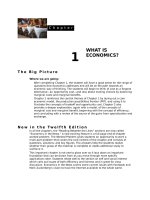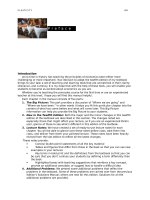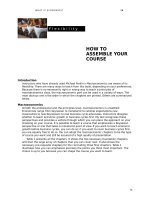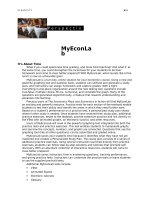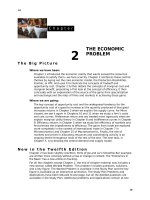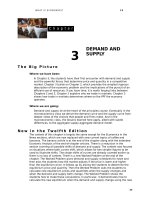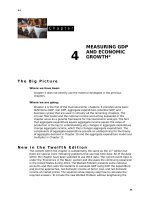Answers to review quizzes marcroeconomics 12e parkin chapter 3
Bạn đang xem bản rút gọn của tài liệu. Xem và tải ngay bản đầy đủ của tài liệu tại đây (561.7 KB, 20 trang )
W H AT I S E C O N O M I C S ?
39
3
DEMAND AND
SUPPLY
Answers to the Review Quizzes
Page 94
1.
What is the distinction between a money price and a relative price?
The money price of a good is the dollar amount that must be paid for it. The
relative price of a good is its money price expressed as a ratio to the money price
of another good. Thus the relative price is the amount of the other good that must
be foregone to purchase a unit of the first good.
2.
Explain why a relative price is an opportunity cost.
The relative price of a good is the opportunity cost of buying that good because it
shows how much of the next best alternative good must be forgone to buy a unit of
the first good.
3.
Think of examples of goods whose relative price has risen or fallen by a large
amount.
Some examples of items where both the money price and the relative price have
risen over time are gasoline, college tuition, and food. Some examples of items
where both the money price and the relative price have fallen over time are
personal computers, HD televisions, and calculators.
Page 99
1.
Define the quantity demanded of a good or service.
The quantity demanded of a good or service is the amount that consumers plan to
buy during a given time period at a particular price.
2.
What is the law of demand and how do we illustrate it?
The law of demand states: “Other things remaining the same, the higher the price
of a good, the smaller is the quantity demanded; and the lower the price of a good,
the greater is the quantity demanded.” The law of demand is illustrated by a
downward-sloping demand curve drawn with the quantity demanded on the
horizontal axis and the price on the vertical axis. The slope is negative to show
that the higher the price of a good, the smaller is the quantity demanded and the
lower the price of a good, the greater is the quantity demanded.
39
40
3.
What does the demand curve tell us about the price that consumers are
willing to pay?
For any fixed quantity of a good available, the vertical distance of the demand
curve from the x-axis shows the maximum price that consumers are willing to pay
for that quantity of the good. The price on the demand curve at this quantity
indicates the marginal benefit to consumers of the last unit consumed at that
quantity.
4.
List all the influences on buying plans that change demand, and for each
influence, say whether it increases or decreases demand.
Influences that change the demand for a good include:
The prices of related goods. A rise (fall) in the price of a substitute increases
(decreases) the demand for the first good. A rise (fall) in the price of a
complement decreases (increases) the demand for the first good.
The expected future price of the good. A rise (fall) in the expected future
price of a good increases (decreases) the demand in the current period.
Income. An increase (decrease) in income increases (decreases) the demand
for a normal good. An increase in income decreases (increases) the demand
for an inferior good.
Expected future income and credit. An increase (decrease) in expected future
income or credit increases (decreases) the demand.
The population. An increase (decrease) in population increases (decreases)
the demand.
People’s preferences. If people’s preferences for a good rise (fall), the
demand increases (decreases).
5.
Why does demand not change when the price of a good changes with no
change in the other influences on buying plans?
If the price of a good falls and nothing else changes, then the quantity of the good
demanded increases and there is a movement down along the demand curve, but
the demand for the good remains unchanged and the demand curve does not
shift.
Page 103
1.
Define the quantity supplied of a good or service.
The quantity supplied of a good or service is the amount of the good or service
that firms plan to sell in a given period of time at a specified price.
2.
What is the law of supply and how do we illustrate it?
The law of supply states that “other things remaining the same, the higher the
price of a good, the greater is the quantity supplied; and the lower the price of a
good, the smaller is the quantity supplied.” The law of supply is illustrated by an
upward-sloping supply curve drawn with the quantity supplied on the horizontal
axis and the price on the vertical axis. The slope is positive to show that the higher
the price of a good, the greater is the quantity supplied and the lower the price of a
good, the smaller is the quantity supplied.
3.
What does the supply curve tell us about the producer’s minimum supply
price?
For any quantity, the vertical distance between the supply curve and the x-axis
shows the minimum price that suppliers must receive to produce that quantity of
output. As a result, the price is the marginal cost of the last unit produced at this
level of output.
40
W H AT I S E C O N O M I C S ?
4.
41
List all the influences on selling plans, and for each influence, say whether it
changes supply.
Changes in the price of the good change the quantity supplied. They do not
change the supply of the good.
Influences that change the supply of a good include:
Prices of factor of production. A rise (fall) in the price of a factor of production
increases firms’ costs of production and decreases (increases) the supply of
the good.
Prices of related goods produced. If the price of a substitute in production
rises (falls), firms decrease (increase) their sales of the original good and the
supply for the original good decreases (increases). A rise (fall) in the price of
a complement in production increases (decreases) production of the original
good, causing the supply of the original good to increase (decrease).
The expected future price of the good. A rise (fall) in the expected future
price of the good decreases (increases) the amount suppliers sell today. This
change in expectations decreases (increases) the supply in the current
period.
The number of sellers. An increase (decrease) in the number of sellers in a
market increases the quantity of the good available at every price, and
increases (decreases) the supply.
Technology. An advance in technology increases the supply.
The state of nature. A good (bad) state of nature, such as good (bad) weather
for agricultural products, increases (decreases) the supply.
5.
What happens to the quantity of cell phones supplied and the supply of cell
phones if the price of a cell phone falls?
If the price of cell phones falls and nothing else changes, then the quantity of cell
phones supplied will decrease and there is a movement down along the supply
curve for cell phones. The supply of cell phones, however, remains unchanged and
the supply curve does not shift.
Page 105
1.
What is the equilibrium price of a good or service?
The equilibrium price is the price at which the quantity demanded by the buyers is
equal to the quantity supplied by the sellers.
2.
Over what range of prices does a shortage arise? What happens to the price
when there is a shortage?
A shortage arises at market prices below the equilibrium price. A shortage causes
the price to rise, decreasing quantity demanded and increasing quantity supplied
until the equilibrium price is attained.
3.
Over what range of prices does a surplus arise? What happens to the price
when there is a surplus?
A surplus arises at market prices above the equilibrium price. A surplus causes the
price to fall, decreasing quantity supplied and increasing quantity demanded until
the equilibrium price is attained.
4.
Why is the price at which the quantity demanded equals the quantity
supplied the equilibrium price?
At the equilibrium price, the quantity demanded by consumers equals the quantity
supplied by producers. At this price, the plans of producers and consumers are
coordinated and there is no influence on the price to move away from equilibrium.
41
42
5.
Why is the equilibrium price the best deal available for both buyers and
sellers?
The equilibrium price reflects that the highest price consumers are willing to pay
for that amount of the good or service and is just equal to the minimum price that
suppliers require for delivering it. Demanders would prefer to pay a lower price,
but suppliers are unwilling to supply that quantity at a lower price. Suppliers would
prefer a higher price, but demanders are unwilling to pay a higher price for that
quantity. Hence neither demanders not suppliers can do business at a better price.
Page 111
What is the effect on the price and quantity of MP3 players (such as the iPod) if
1.
The price of a PC falls or the price of an MP3 download rises? (Draw the
diagrams!)
A fall in the price of a PC decreases the demand for MP3 players because a PC is a
substitute for an MP3 player. The demand curve for MP3 players shifts leftward.
Supply remains unchanged. The price of an MP3 player falls and the quantity of
MP3 players decreases.
A rise in the price of an MP3 download decreases the demand for MP3 players
because an MP3 download is a complement of an MP3 player. The demand curve
for MP3 players shifts leftward. Supply remains unchanged. The price of an MP3
player falls and the quantity of MP3 players decreases.
2.
More firms produce MP3 players or electronics workers’ wages rise? (Draw the
diagrams!)
An increase in the number of firms that produce MP3 players increases the supply
of MP3 players. The supply curve of MP3 players shifts rightward. Demand remains
unchanged. The price of an MP3 player falls and the quantity of MP3 players
increases. You can illustrate this outcome by drawing a diagram like Figure 3.9 on
page 108.
A rise in the wages of electronic workers decreases the supply of MP3 players
because it increases the cost of producing MP3 players. The supply curve of MP3
players shifts leftward. Demand remains unchanged. The price of an MP3 player
rises and the quantity of MP3 players decreases.
42
3.
Any two of these events in questions 1 and 2 occur together? (Draw the
diagrams!)
There are six combinations:
(1) If the price of a PC falls and the price of an MP3 download rises, demand
decreases, supply is unchanged, so the price falls and the quantity
decreases.
(2) If the price of a PC falls and more firms produce MP3 players, demand
decreases and supply increases so the price falls and the quantity might
increase, decrease, or not change.
(3) If the price of PC falls and the wages paid electronic workers rise, demand
decreases and supply decreases so the quantity decreases and the price
might rise, fall, or not change.
(4) If the price of an MP3 download rises and more firms produce MP3
players, demand decreases and supply increases so the price falls and
quantity might increase or decrease or remain the same.
(5) If the price of an MP3 download falls and the wages paid electronic
workers rise, demand decreases and supply decreases so the quantity
decreases and the price might rise or fall or remain the same.
(6) If more firms produce MP3 players and the wages paid electronics workers
rise, supply might increase or decrease or remain unchanged, demand is
unchanged, so the outcome cannot be predicted.
38
CHAPTER 3
Answers to the Study Plan Problems and
Applications
1.
In April 2014, the money price of a carton of milk was $2.01 and the money
price of gallon of gasoline was $3.63. Calculate the relative price of a gallon
of gasoline in terms of milk.
The relative price of a gallon of gasoline in terms of milk equals ($3.63 per gallon
of gasoline)/($2.01 per carton of milk) = 1.81 cartons of milk per gallon of
gasoline.
2.
The price of food increased during the past year.
a. Explain why the law of demand applies to food just as it does to other goods
and services.
The law of demand applies to food because there is both a substitution and an
income effect that reinforce each other. When the price of food rises, people
substitute to different foods. For instance, some might substitute home cooked
meals for dining at a restaurant. And when the price rises, there is a negative
income effect, so people buy less food overall with the rising price. On both counts,
the higher price of food decreases the quantity of food demanded.
b. Explain how the substitution effect influences food purchases when the price
of food rises and other things remain the same.
When the price of food rises, people substitute away from (some) foods and toward
other foods and other activities. People substitute cheaper foods for more
expensive foods and they also substitute diets for food.
c. Explain how the income effect influences food purchases and provide some
examples of the income effect.
Food is a normal good so a rise in the price, which decreases people’s real
incomes, decreases the quantity of food demanded. In the United States,
restaurants suffer as the negative income effect from a higher price of food leads
people to cut back their trips to restaurants. At home, people will buy fewer steaks
and instead will buy more noodles. In poor countries (and among the poor in the
United States), people literally eat less when the price of food rises and in
extremely poor countries starvation increases.
3.
Which of the following goods are likely substitutes and which are likely
complements? (You may use an item in more than once.):
coal, oil, natural gas, wheat, corn, pasta, pizza, sausage, skateboard, roller
blades,
video game, laptop, iPad, cellphone, text message, email
Substitutes include: coal and oil; coal and natural gas; oil and natural gas; wheat
and corn; pasta and pizza; pasta and sausage; pizza and sausage (they type of
sausage that cannot be used as a topping on pizza); skateboard and roller blades;
skateboard and video game; roller blades and video game; laptop and iPad; and,
text message and email.
Complements include: pizza and sausage (the type of sausage that can be used as
a topping on pizza); skateboard and iPad; roller blades and iPad; video game (those
played on a computer) and laptop; cellphone and text message; and, cellphone
(smart cellphone) and email.
4.
As the average income in China continues to increase, explain how the
following would change:
a. The demand for beef
Beef is a normal good. The increase in income increases the demand for beef.
D E M A N D A N D S U P P LY
b. The demand for rice
Rice is probably an inferior good. The increase in income decreases the demand
for rice.
5.
In 2013, the price of corn fell and some corn farmers will switch from growing
corn in 2014 to growing soybeans.
a. Does this fact illustrate the law of demand or the law of supply? Explain your
answer.
This fact illustrates the law of supply: the lower price of corn decreases the
quantity of corn grown.
b. Why would a corn farmer grow soybeans?
Corn and soybeans are substitutes in production and soybeans have become more
profitable. A corn farmer would switch to soybeans because the profit from growing
soybeans exceeds that from growing corn.
6.
Dairies make low-fat milk from full-cream milk, and in the process they
produce cream, which is made into ice cream. The following events occur one
at a time:
(i) The wage rate of dairy workers rises.
(ii) The price of cream rises.
(iii)
The price of low-fat milk rises.
(iv)
With a drought forecasted, dairies raise their expected price of low-fat
milk next year.
(v) New technology lowers the cost of producing ice cream.
Explain the effect of each event on the supply of low-fat milk.
(i) Dairy workers are a factor used to produce low-fat milk. The price of a factor of
production rises, which decreases the supply of low-fat milk.
(ii) Cream and low fat milk are complements in production. The price of a
complement in production rises, which increases the supply of low fat milk.
(iii) A rise in the price of low-fat milk does not change the supply of low-fat milk. It
does, however, increase the quantity of low-fat milk supplied.
(iv) The higher expected price of low-fat milk decreases the (current) supply of lowfat milk.
(v) Ice cream and low-fat milk are complements in production. The lower cost of
producing ice cream increases the quantity of ice cream produced, which
increases the supply of low-fat milk.
7.
The demand and supply schedules
for gum are in the table.
a. Suppose that the price of gum is
70¢ a pack. Describe the situation
in the gum market and explain
how the price adjusts.
Price
(cents per
pack)
20
40
60
80
Quantity
Quantity
demand
supplied
ed
(millions of packs a
week)
180
60
140
100
100
140
60
180
At 70 cents a pack, there is a surplus
of gum and the price falls. At 70
cents a pack, the quantity
demanded is 80 million packs a
week and the quantity supplied is 160 million packs a week. There is a surplus of
80 million packs a week. The price falls until market equilibrium is restored at a
price of 50 cents a pack.
39
40
CHAPTER 3
b. Suppose that the price of gum is 30¢ a pack. Describe the situation in the
gum market and explain how the price adjusts.
At 30 cents a pack, there is a shortage of gum and the price rises. At 30 cents a
pack, the quantity demanded is 160 million packs a week and the quantity
supplied is 80 million packs a week. There is a shortage of 80 million packs a
week. The price rises until market equilibrium is restored at a price of 50 cents a
pack.
8.
The following events occur one at a time:
(i) The price of crude oil rises.
(ii) The price of a car rises.
(iii) All speed limits on highways are abolished.
(iv) Robots cut car production costs.
Explain the effect of each of these events on the market for gasoline.
(ii) and (iii) and (iv) change the demand for gasoline. The demand for gasoline will
change if the price of a car rises, all speed limits on highways are abolished, or
robot production cuts the cost of producing a car. If the price of a car rises, the
quantity of cars bought decrease and the demand for gasoline decreases. If all
speed limits on highways are abolished, people will drive faster and use more
gasoline. The demand for gasoline increases. If robot production plants lower the
cost of producing a car, the supply of cars will increase. With no change in the
demand for cars, the price of a car will fall and more cars will be bought. The
demand for gasoline increases.
(i) changes the supply of gasoline. The supply of gasoline will change if the price of
crude oil (a factor of production used in the production of gasoline) changes. If the
price of crude oil rises, the cost of producing gasoline rises and the supply of
gasoline decreases.
9.
In Problem 7, a fire destroys some
factories that produce gum and the
quantity of gum supplied decreases
by 40 million packs a week at each
price.
a. Explain what happens in the market
for gum and draw a graph to
illustrate the changes.
As the number of gum-producing
factories decreases, the supply of gum
decreases. There is a new supply
schedule and, in Figure 3.1, the supply
curves shifts leftward by 40 million
packs at each price to the new supply
curve S1. After the fire, the quantity
supplied at 50 cents is now only 80
million packs, and there is a shortage
of gum. The price rises to 60 cents a
pack, at which the new quantity supplied equals the quantity demanded. The new
equilibrium price is 60 cents and the new equilibrium quantity is 100 million packs
a week.
D E M A N D A N D S U P P LY
b. If, at the time as the fire the teenage
population increases and the
quantity of gum demanded
increases 40 million packs a week at
each price. What is the new market
equilibrium? Show the changes on
your graph.
The new price is 70 cents a pack, and
the quantity is 120 million packs a
week. The demand for gum increases
and the demand curve shifts rightward
by 40 million packs at each price.
Supply decreases by 40 millions packs
a week and the supply curve shifts
leftward by 40 million packs at each
price. These changes are shown in
Figure 3.2 by the shift of the demand
curve from D to D1 and the shift of the
supply curve from S to S1. At any price
below 70 cents a pack there is a shortage of gum. The price of gum rises until the
shortage is eliminated.
41
42
10.
CHAPTER 3
Frigid Florida Winter is Bad News for Tomato Lovers
An unusually cold January in Florida destroyed entire fields of tomatoes.
Florida’s growers are shipping only a quarter of their usual 5 million pounds a
week. The price has risen from $6.50 for a 25-pound box a year ago to $30 now.
Source: USA Today, March 3, 2010
a. Make a graph to illustrate the market for tomatoes before the unusually cold
January and show how the events in the news clip influence the market for
tomatoes.
Figure 3.3 shows the tomato market in
January 2009 and January 2010. In both
years the demand curve is labeled D.
The supply curve for 2009 is labeled S0
and the supply curve for 2010 is
labeled S1. The supply curve for 2010
lies to the left of the supply curve for
2009 because the cold January was a
bad state of nature and decreased the
supply of tomatoes.
The cold weather shifted the supply
curve leftward, from S0 to S1. The
equilibrium price of a box of tomatoes
rises from $6.25 per box to $30.00 per
box and the equilibrium quantity
decreases from 5 million pounds of
tomatoes per week to 1.25 million
pounds of tomatoes per week.
b. Why is the news “bad for tomato
lovers”?
The news is bad for tomato lovers because the price of tomatoes rises and “tomato
lovers” respond to the higher price by decreasing the quantity of tomatoes they
consume. Tomato lovers consume fewer of the tomatoes they love.
D E M A N D A N D S U P P LY
Answers to Additional Problems and Applications
11.
What features of the world market for crude oil make it a competitive market?
The world oil market is a competitive market because there are a large number of
sellers and a large number of buyers. There are so many sellers and so many
buyers that no individual seller or individual buyer can influence he price of oil.
12.
The money price of a Persian rug is $100 and the money price of an Egyptian
kaftan is $25.
a. What is the opportunity cost of a Persian rug in terms of an Egyptian kaftan?
A Persian rug costs $100 and an Egyptian kaftan costs $25. Purchasing 1 Persian
rug, forces the buyer to give up 4 Egyptian kaftans. So the opportunity cost of a
Persian rug in terms of Egyptian kaftans is 4 Egyptian kaftans per Persian rug.
b. What is the relative price of an Egyptian kaftan in terms of Persian rugs?
The relative price of an Egyptian kaftan in terms of Persian rugs equals ($25 per
Egyptian kaftan)/($100 per Persian rug), which is 1/4 of a Persian rug per Egyptian
kaftan.
13.
The price of gasoline has increased during the past year.
a. Explain why the law of demand applies to gasoline just as it does to all other
goods and services.
When the price of gasoline rises, people decrease the quantity of gasoline they
demand. Both the substitution effect and the income effect lead consumers to
decrease the quantity of gasoline demanded.
b. Explain how the substitution effect influences gasoline purchases and
provide some examples of substitutions that people might make when the
price of gasoline rises and other things remain the same.
When the price of gasoline rises, people substitute other goods and services for
gasoline. For instance, people substitute public transport (such as buses),
carpools, motorcycles, walking, and bicycles for driving alone in a car to work.
c. Explain how the income effect influences gasoline purchases and provide
some examples of the income effects that might occur when the price of
gasoline rises and other things remain the same.
When the price of gasoline rises, people’s real incomes fall. People respond by
decreasing their demand for normal goods, such as gasoline. In the gasoline
market, some people trade in large, fuel guzzling cars because they can no longer
afford to fuel the large vehicle. Others will not purchase a car or truck because
they are not able to afford the gasoline necessary to use it.
14.
Think about the demand for the three game consoles: Xbox One, PlayStation
4, and Wii U. Explain the effect of the following events on the demand for
Xbox One games and the quantity of Xbox One games demanded, other
things remaining the same. The events are:
a. The price of an Xbox One falls.
An Xbox One and an Xbox One game are complements. When the price of an Xbox
One falls, consumers respond by increasing the quantity of Xbox Ones demanded
so the equilibrium quantity of Xbox Ones increases. Consumers increase their
demand for Xbox one games because an Xbox One console is useless without Xbox
One games.
b. The prices of a PlayStation 4 and a Wii U fall.
A PlayStation 4 and a Wii U are substitutes for an Xbox One. When these game
consoles fall in price, the demand for Xbox One consoles decreases and so the
equilibrium quantity of Xbox Ones decreases. Consumers decrease their demand
43
44
CHAPTER 3
for Xbox One games because an Xbox One game is useless without an Xbox One
console.
c. The number of people writing and producing Xbox One games increases.
The increase in the number of people writing Xbox One games increases the
supply of Xbox One games. The demand for Xbox One games does not change but
the increase in the supply lowers the price of an Xbox One game. The fall in the
price of Xbox One games increases the quantity of Xbox Ones demanded.
d. Consumers’ incomes increase.
Xbox One games are surely a normal good. So an increase in consumers’ incomes
increases the demand for Xbox One games.
e. Programmers who write code for Xbox One games become more costly to
hire.
The increase in the cost of programmers decreases the supply of Xbox One games.
When the supply of a good or service decreases, the price of that good or service
rises. Xbox One games are not an exception, so the price of an Xbox One game
rises. The rise in the price of an Xbox One game decreases the quantity of Xbox
One games demanded.
f.
The expected future price of an Xbox One game falls.
When the price of an Xbox One game is expected to fall, the (current) demand for
Xbox One games decreases.
g. A new game console that is a close substitute for Xbox One comes onto the
market.
The new game console decreases the demand for Xbox One consoles. As a result,
the equilibrium quantity of Xbox One consoles decreases. Consumers decrease
their demand for Xbox One games because an Xbox One game is useless without
an Xbox One console.
15.
Classify the following pairs of goods and services as substitutes in production,
complements in production, or neither.
a. Lumber and sawdust
For a sawmill that produces both lumber and sawdust, they are complements in
production.
b. Condominiums and bungalows
For a construction company that builds both condominiums and bungalows, they
are substitutes in production. (For a consumer, they are substitutes.)
c. Cheeseburger and fries
For a restaurant that produces both cheeseburgers and fries, they are neither
complements nor substitutes in production. (For consumers, they are
complements.)
d. Cars and gasoline
Cars and gasoline are neither complements nor substitutes in production. (For a
consumer, cars and gasoline are complements.)
e. Cappuccino and latte
For a café that produces both cappuccino and latte, they are substitutes in
production. (For a consumer, cappuccino and latte are substitutes.)
16.
When a farmer uses raw milk to produce skim milk, he also produces cream
which is used to make butter.
a. Explain how a rise in the price of cream influences the supply of skim milk.
The rise in the price of cream motivates farmers to make more cream, which
increases the quantity supplied of skim milk, as skim milk and cream are
complements in production.
D E M A N D A N D S U P P LY
b. Explain how a rise in the price of cream influences the supply of butter.
As cream is a factor of production used to make butter, a rise in the price of cream
will reduce the supply of butter.
45
46
17.
CHAPTER 3
New Maple Syrup Sap Method
With the new way to tap maple trees, farmers could produce 10 times as
much maple syrup per acre.
Source: cbc.ca, February 5, 2014
Will the new method change the supply of maple syrup or the quantity
supplied of maple syrup, other things remaining the same. Explain.
The new technology increases the supply of maple syrup. At each price, the new
technology increases the quantity that will be supplied. The supply curve shifts
rightward.
Use Figure 3.4 to work Problems 18 and 19.
18.a. Label the curves. Which curve shows
the willingness to pay for a pizza?
The demand curve is the downward
sloping curve and the supply curve is
the upward sloping curve. The demand
curve shows the willingness to pay for a
pizza.
b. If the price of a pizza is $16, is there
a shortage or a surplus and does the
price rise or fall?
If the price of a pizza is $16, there is a
surplus of pizza; the quantity supplied
of pizzas exceeds the quantity
demanded. The surplus forces the price
lower to the equilibrium price of $14 a
pizza.
c. Sellers want to receive the highest
possible price, so why would they be
willing to accept less than $16 a pizza?
Sellers are willing to accept less than $16 because if they charge $16 the surplus
means that some sellers have unsold pizzas. From their perspective it is better to
have a lower price for the pizza and sell the (decreased) quantity they produce
than to keep the price at $16 and be left with unsold pizza.
19.a. If the price of a pizza is $12, is there a shortage or a surplus and does the
price rise or fall?
If the price of a pizza is $12, there is a shortage of pizza; the quantity demanded of
pizzas exceeds the quantity supplied. The shortage forces the price higher to the
equilibrium price of $14 a pizza.
b. Buyers want to pay the lowest possible price, so why would they be willing
to pay more than $12 for a pizza?
If the price of a pizza is $12 the shortage means that not all buyers can buy a
pizza. From their perspective they would rather pay more than $12 and be able to
purchase a pizza than to keep the price at $12 and leave them without a pizza.
D E M A N D A N D S U P P LY
20.
The demand and supply
schedules for potato chips are in
the table.
a. Draw a graph of the potato chip
market and mark in the
equilibrium price and quantity.
Figure 3.5 draws the supply and
demand curves for this market.
The equilibrium price is 65¢ a
bag, and the equilibrium quantity
is 145 million bags a week.
Price
(cents per
bag)
50
60
70
80
90
100
Quantity
Quantity
demand
supplied
ed
(millions of bags a
week)
160
130
150
140
140
150
130
160
120
170
110
180
b. If the price is 60¢ a bag, is there
a shortage or a surplus, and how
does the price adjust?
At 60¢ a bag, there is a shortage of
potato chips and the price rises. At
60¢ a bag, the quantity demanded is
150 million bags a week and the
quantity supplied is 140 million bags a
week. The difference is a shortage of
10 million bags a week. The price rises
until market equilibrium is restored—
65¢ a bag and 145 million bags a
week.
21.
In Problem 20, a new dip increases
the quantity of potato chips that
people want to buy by 30 million bags
per week at each price.
a. Does the demand for chips change?
Does the supply of chips change? Describe the change.
As the new dip comes onto the market, the demand for potato chips increases.
Supply does not change. The demand curves shifts rightward.
b. How do the equilibrium price and
equilibrium quantity of chips
change?
Demand increases by 30 million bags
a week. The demand curve shifts
rightward as shown in Figure 3.6 by
the shift from D to D1. The quantity
demanded at each price increases by
30 million bags. The quantity
demanded at 65¢ is now 175 million
bags a week of potato chips. The price
rises to 80¢ a bag, at which the
quantity supplied equals the quantity
demanded (160 million bags a week).
The new equilibrium price is 80¢ per
bag and the new equilibrium quantity
is 160 million bags.
47
48
22.
CHAPTER 3
In Problem 20, if a virus destroys potato crops and the quantity of potato
chips produced decreases by 40 million bags a week at each price, how does
the supply of chips change?
The supply of potato chips decreases, and the supply curve shifts leftward by 40
million bags. The price rises to 85¢ a bag and the quantity decreases to 125
million bags a week.
23.
If the virus in Problem 22 hits just as the new dip in Problem 21 comes onto
the market, how do the equilibrium price and equilibrium quantity of chips
change?
The result by itself of the new dip entering the market is a price of 80¢ a bag and a
quantity of 160 million bags. But now with the virus affecting the market, at this
price there is a shortage of potato chips. The price of potato chips rises until the
shortage is eliminated. The new equilibrium price is 100¢ a bag, and the new
equilibrium quantity is 140 million bags a week.
24.
Asian Rubber Farmers Switch Crops as Prices Dive
For the last four years, the price of rubber has been falling. With the sagging
price, many Southeast Asian producers of rubber have switched to other
crops such as oil palm, and those employed in rubber tapping have begun to
look for jobs in factories and mines.
Source: Reuters, May 29, 2014
a. Explain how the market for rubber would have changed if farmers had
continued to plant rubber trees instead of switching to palm oil trees.
If farmers continued to plant rubber trees, the supply of rubber would have
increased. The demand for rubber would have remained unchanged. The supply
curve would have shifted rightward as a result of the increase in supply and the
demand curve would have remained unchanged. As a result, the equilibrium price
of rubber would have decreased and the equilibrium quantity would have
increased.
b. Describe the changes in demand and supply in the market for palm oil.
Farmers are cultivating oil palm, which bears fruit within three years unlike rubber
trees that takes six years to mature and produce latex. As a result, they have
increased the supply of palm oil, while the demand for palm oil did not change.
25.
“Popcorn Movie” Experience Gets
Pricier
Cinemas are raising the price of
popcorn. Demand for field corn, which
is used for animal feed, corn syrup, and
ethanol, has increased and its price has
exploded. That’s caused some farmers
to shift from growing popcorn to easierto-grow field corn.
Source: USA Today, May 24, 2008
Explain and illustrate graphically the
events described in the news clip in the
market for
a. Popcorn
As illustrated in Figure 3.7, the farmers’
actions decrease the supply of popcorn
and the supply curve of popcorn shifts
D E M A N D A N D S U P P LY
leftward. The demand curve does not shift. The equilibrium price of popcorn rises
and the quantity decreases.
49
50
CHAPTER 3
b. Movie tickets
In the market for movie tickets—
essentially the market for viewing
movies in the theater—popcorn and
viewing movies are complements. The
increase in the price of popcorn
decreases the demand for attending
movies in the theater. As a result, Figure
3.8 shows the demand curve shifting
leftward. The equilibrium price of
attending a movie in the theater falls
and the equilibrium quantity decreases.
26.
Watch Out for Rising Dry-Cleaning Bills
In the past year, the price of dry-cleaning solvent doubled. More than 4,000
dry cleaners across the United States disappeared as budget-conscious
consumers cut back. This year the price of hangers used by dry cleaners is
expected to double.
Source: CNN Money, June 4, 2012
a. Explain the effect of rising solvent prices on the market for dry cleaning.
Solvents are used to produce dry cleaning, so a rise in the price of solvents
increases the cost of dry cleaning. The increase in the cost of dry cleaning
decreases the supply of dry cleaning and the supply curve of dry cleaning shifts
leftward. The demand for dry cleaning does not change. By itself, the decrease in
the supply raises the equilibrium price of dry cleaning and decreases the
equilibrium quantity of dry cleaning.
b. Explain the effect of consumers becoming more budget conscious along
with the rising price of solvent on the price of dry cleaning.
Consumers becoming more budget conscious means that the demand for dry
cleaning decreases and the demand curve for dry cleaning shifts leftward.
Combined with the decrease in supply from rising solvent prices, the equilibrium
quantity of dry cleaning decreases. The effect on the equilibrium price of dry
cleaning, however, is ambiguous. If the decrease in supply exceeds the decrease in
demand, the price rises; if the decrease in supply is less than the decrease in
demand, the price falls; and, if the decrease in supply equals the decrease in
demand, the price does not change.
c. If the price of hangers does rise this year, do you expect additional dry
cleaners to disappear? Explain why or why not.
The increase in the price of hangers raises the costs of dry cleaners but the cost
increase is much smaller than the cost increase that resulted from the doubling of
the price of dry-cleaning solvent. Therefore the decrease in supply is smaller,
which means that the decrease in the equilibrium quantity of dry cleaning also is
smaller. If the small decrease in the equilibrium quantity leads some additional dry
cleaners to close, the number will be small.
D E M A N D A N D S U P P LY
Economics in the News
27.
After you have studied Economics in the news on pp. 112–113, answer the
following questions:
a. What would happen to the price of bananas if TR4 spread to Central
America?
The price of bananas would rise.
b. What are some of the substitutes for bananas and what would happen to
demand, supply, price, and quantity in the markets for these items if TR4
were to come to America?
Banana consumers could substitute other fruits, such as apples, peaches, or
apricots. These changes would not change the supply of these products. The
demand for these products, however, would increase, thereby raising their price
and quantity.
c. What are some of the complements of bananas and what would happen to
demand, supply, price, and quantity in the markets for these items if TR4
were to come to America?
The classic complement for bananas is cereal. A rise in the price of bananas
decreases the demand for cereal, so the demand curve for cereal shifts leftward.
The supply of cereal is unaffected. The decrease in the demand for cereal lowers
the equilibrium price of cereal and decreases the equilibrium quantity of cereal.
d. When the price of bananas increased in 2008, did it rise by as much as the
rise in the rise in the price of oil? Why or why not?
In 2008 the price of oil rose by about 70 percent, so the 20 percent price hike in the
price of bananas was much less than the rise in price of oil. The price of oil is a
cost of producing bananas. When the price of oil rose, the cost of producing
bananas rose, so that the supply of bananas decreased. In response, the price of
bananas rose. But there are other costs of producing bananas. The other costs did
not rise by as much as the price of oil, so the decrease in the supply of bananas
was smaller and, accordingly, the rise in the price of bananas was less than of oil.
e. Why would the expectation of the future arrival of TR4 in the Americas have
little or no effect on today's price of bananas?
If TR4 arrives in the Americas, the supply of bananas will decrease, thereby raising
the price. The rise in the future expected for some goods can decrease the current
supply and increase the current demand. But these changes assume that the good
is storable. For example, the current supply decreases when the expected future
price rises because producers store the product to sell in the future when its price
is expected to be higher. Bananas, however, are not storable. Therefore producers
(and demanders) do not respond to the higher expected future price.
51
52
CHAPTER 3


